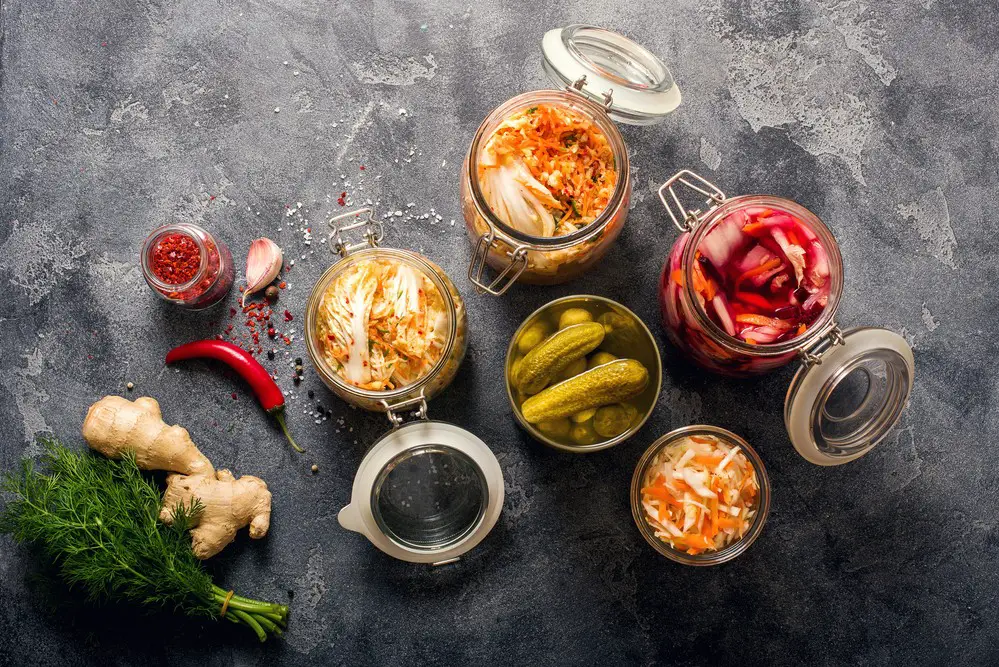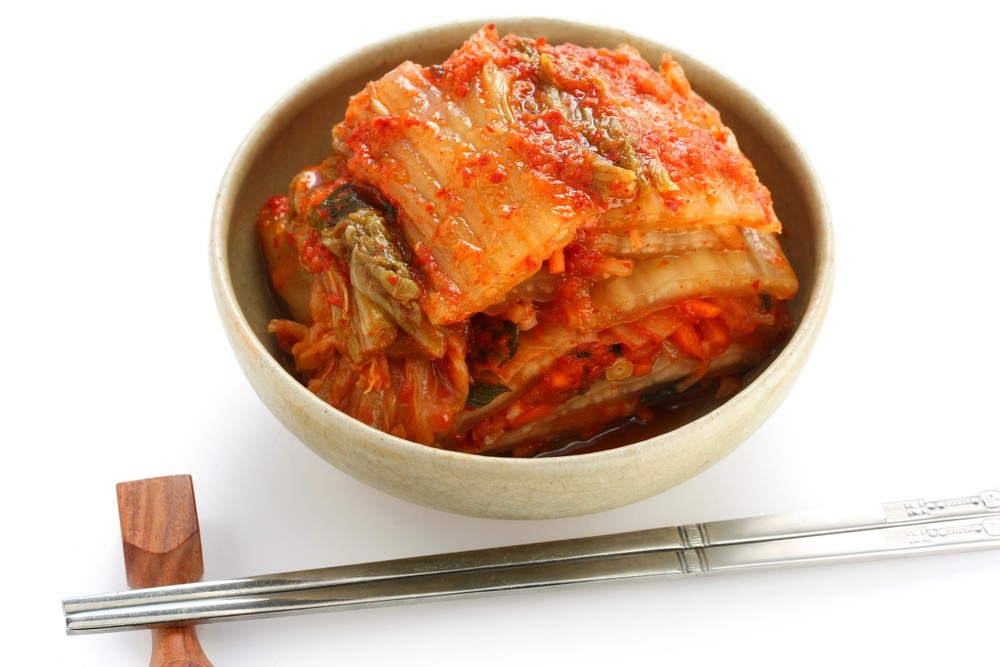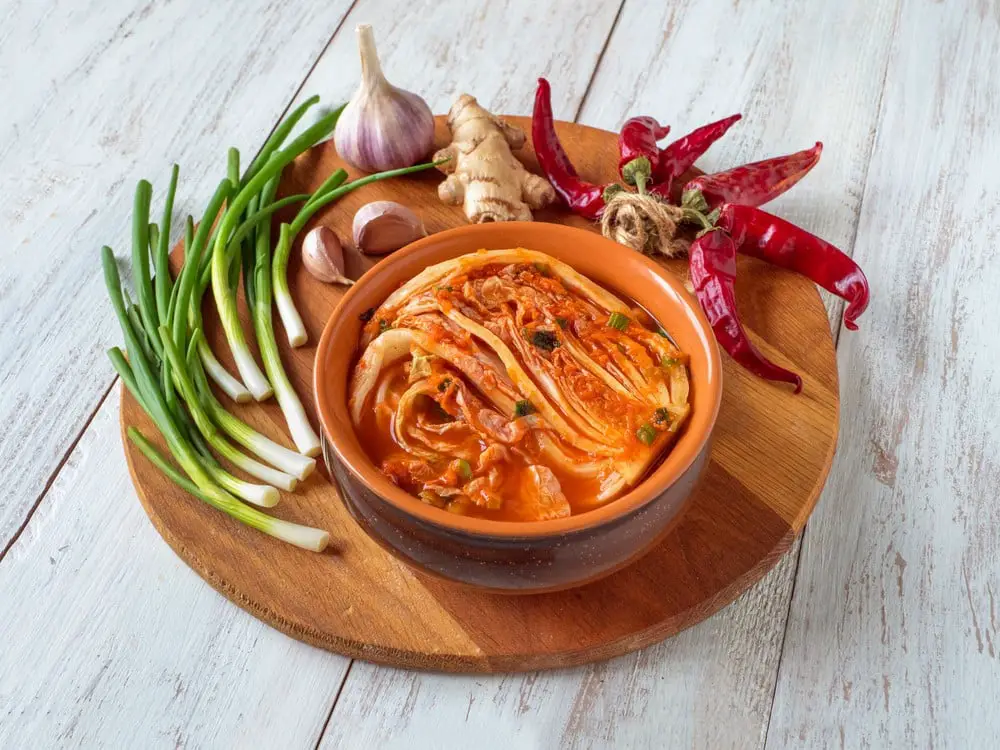Scientists have found that including fermented foods in the diet decreases inflammation, improves digestion, and increases healthy microorganisms in the gut thanks to the probiotics created during the fermentation process. Fermented foods include sauerkraut, sourdough, tofu, miso, and kimchi.
Kimchi is a colorful South Korean food comprising salted and fermented vegetables. It’s so flavorful that you can eat it as is, serve it as a side, and add it to dishes like tofu scramble. However, kimchi is not always vegan because shop-bought varieties often contain fermented seafood like salted shrimp or fish sauce.
Here’s how to make vegan kimchi, allowing you to indulge in this delicious food while enjoying its health benefits.
Tangy Vegan Kimchi Recipe
 Preparing kimchi requires a few important steps, including cleanliness and fermentation. However, once it’s ready to eat, it has a tangy, pleasant smell. After fermentation, you can keep it in the fridge for weeks to accompany or add to your dishes.
Preparing kimchi requires a few important steps, including cleanliness and fermentation. However, once it’s ready to eat, it has a tangy, pleasant smell. After fermentation, you can keep it in the fridge for weeks to accompany or add to your dishes.
Cabbage, green onions, garlic, ginger, and chilis are the base ingredients for kimchi, but you can add vegetables like daikon radish and carrots.
Several ingredients can replace the seafood sauce usually used in kimchi; these include miso, soy sauce, and tamari.
Now that you know more about the ingredients you can use, here’s how to make kimchi from Minimalist Baker. The recipe yields a tangy and spicy kimchi to add to any dish.
Step-by-Step Vegan Kimchi Guide
Sticking to the traditional way of making kimchi is complicated. The intensive process of making it also relies on allowing enough fermentation time.
However, this doesn’t mean you cannot learn how to make kimchi. Here’s a step-by-step guide to make the process less complicated and faster:
- The most important part of the process is cleanliness, which prevents harmful bacteria from stopping the fermentation process. Therefore, you need clean hands and equipment when working with the ingredients.
- Quarter your preferred cabbage and remove the core.
- Wash and dry all vegetables you will use in the kimchi.
- Adding the salt helps to draw out the moisture from the cabbage to soften it. Turn the cabbage every half hour to help drain out most of its moisture.
- When preparing the spice mixture for the kimchi, you can adjust the chili flakes according to how mild or hot you prefer.
- If your recipe calls for Korean red chili flakes or powder (gochu-garu) you can replace it with standard if you can’t find it.
- Rinse and dry the cabbage once it has released moisture before mixing it until well-coated with the rest of the ingredients.
- Place the mixture in sterilized containers, and allow the fermentation to begin!
Flavorful Homemade Kimchi Recipe
Maangchi has a huge knowledge of Korean cooking since she was born and raised there. The author has several cookbooks, but you can also get ideas for creating authentic Korean recipes from her website and YouTube channel.
The blogger wasn’t pleased that soy sauce didn’t replace the umami of fish sauce. She developed a vegetarian stock that works perfectly in this flavorful and homemade vegan kimchi.
Maangchi’s kimchi paste includes glutinous rice flour, garlic, onion, salt, and gochu-garu. She also includes carrots for their flavor and color. You can sprinkle with sesame if you want to eat the kimchi immediately. The kimchi requires up to two days to ferment at room temperature and two weeks in the refrigerator. It continues to ferment and gets more sour with time. But the remaining kimchi must remain covered with liquid every time you remove some to serve.
Easy Vegan Kimchi at Home
Here’s an easy kimchi recipe with an umami flavor, even though it doesn’t include a fermented seafood product.
Easy Vegan Kimchi Recipe
Ingredients
- 1 large Napa cabbage, leaves separated and core removed
- 1 small daikon radish, sliced into thin rounds
- 8 scallions, of which you roughly chop the greens and reserve the whites
- Kosher salt
- 8 garlic cloves
- A 2-inch knob of ginger, peeled
- 1/2 cup gochugaru (Korean chile powder)
- 2 T. miso paste (red or white)
- 1 T. sugar
- 1 cup water
Instructions
- Place the cabbage leaves, daikon, and scallion greens in a bowl and sprinkle with two tablespoons of kosher salt. Toss, cover, and leave at room temperature until cabbage has wilted and released about ½ cup of liquid. It can take anything from an hour to twelve hours.
- While wilting the cabbage, process the scallion whites, garlic, ginger, chile powder, miso paste, and sugar in a food processor or blender to form a rough paste. Scrape down the sides as needed.
- Add the chile mixture to the cabbage and gently turn to coat.
- Add the water to the mixture and taste it to see if it needs more salt. As a rule, its saltiness should match that of seawater.
- The kimchi is ready to pack tightly in mason jars, ensuring the release of air bubbles trapped in the bottom of the jar. You can use chopsticks for this. Add the leftover liquid from the bowl to cover the kimchi. Seal tightly.
- Place the sealed jars in a cool room for 24 hours and refrigerate for at least a week before eating so that they start to ferment. You can start eating as soon as it has the sourness you prefer.
Quick and Tasty Kimchi Recipe

Here’s a quick and tasty kimchi recipe for Homemade Vegan Kimchi from Pick Up Limes. The napa cabbage requires 2 hours of soak time. The paste and vegetables require another 20 minutes to prepare. It will need two days to ferment before you can start consuming.
Here are some tips on making the kimchi from the recipe’s author to ensure you get the perfect results every time.
- Use iodine-free salt since other salts hinder the fermentation process.
- Prefer to use gochu-garu or taeyang-cho for an authentic flavor. Adjust the chili to your preferred spice levels.
- Garlic chives give the kimchi its strong garlic flavor.
- It will take one day less to ferment the kimchi in summer.
Master the Art of Vegan Kimchi Making
 The ingredients in kimchi ripen in their salt water, meaning that with time, its flavor profile increases. Once it reaches these higher acidity levels, you can use your kimchi in your cooking to soften its flavor.
The ingredients in kimchi ripen in their salt water, meaning that with time, its flavor profile increases. Once it reaches these higher acidity levels, you can use your kimchi in your cooking to soften its flavor.
Some tips to follow include:
- Use fish sauce alternatives like red miso paste (the glutamic acid gives kimchi its bright color), soy sauce, or tamari (a gluten-free option).
- Even though sliced cabbage is the most traditional, you can incorporate other vegetables or even leave out the cabbage altogether. Common additions include scallions, red chili, carrots, cucumbers, and daikon radishes.
- Research the fermentation times of your kimchi since it can take a few days to weeks. The more intense you prefer it, the longer you must leave it. Once the kimchi reaches your desired flavor and texture, store it in the refrigerator, where its fermentation process slows.
- Cleanliness during manufacture and proper storage will ensure your kimchi won’t go bad.
Delicious Vegan Kimchi in Minutes
Vegan fish sauce is not too challenging to recreate. Here’s a vegan kimchi from Cook Republic. Sneh, the blogger, created the recipe for a slightly sweeter kimchi after much research on fermentation. Her secret is using pineapple juice with other ingredients to create her vegan fish sauce. The result is delicious.
Here’s how to make vegan kimchi from Sneh with this Easy 30 Min Kimchi and Vegan Sauce recipe. Leave the kimchi in direct sunlight for an hour, and it’s ready to consume, but it will start reaching the right levels of sourness after 24 hours.
Try This Vegan Kimchi Recipe Today
Kimchi comes in several interesting varieties and colors. You can mix vegetables or use them individually with the spices. There are milder varieties, like White Kimchi and a stuffed spicy cucumber known as Oi Sobagi, meant to be eaten in a few days.
In the search to find how to make vegan kimchi, it appears that everyone loves this versatile ingredient. It’s easier to find cabbage; therefore, most recipes will include it. Even though kimchi takes days to ferment, and you will need a few hours to drain the liquid from the cabbage, it’s pretty easy to make.
Whether you ferment the kimchi in or out of the fridge will depend on how fast you want it to reach its sour flavor. Don’t worry if your kimchi releases gases when you open the lid. That popping sound and bubbles in the liquid are typical of fermentation.
Here’s an Easy Vegan Kimchi Recipe from Masterclass to try today. It has a quick prep time after you have prepped the cabbage. In this recipe, you rub the cabbage leaves with salt until they soften, and then you soak them weighed down in cold water for about two hours. The recipe yields 1 quart of the classic Baechu-kimchi, the most popular variety.
Making vegan kimchi is easier than you imagined, so prep a batch today and enjoy it for its flavor and health benefits.

